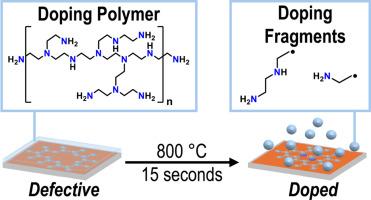支化聚乙烯亚胺碎片化实现高效氮掺杂和缺陷石墨烯愈合
IF 11.6
2区 材料科学
Q1 CHEMISTRY, PHYSICAL
引用次数: 0
摘要
一种新兴的合成后掺杂/修复方法是通过聚合物涂层的快速热降解来修复有缺陷的石墨烯层,这是一种很有前途的方法,可以减轻几乎在制造工作流程的每个步骤中引入的缺陷。然而,含掺杂剂聚合物的热破碎过程及其与缺陷的相互作用仍然未知,这阻碍了石墨烯以外的其他掺杂剂和二维(2D)材料的最佳使用和应用。为此,本研究采用热解-气相色谱/质谱(Py-GC/MS)串联方法和反应分子动力学(RMD)模拟了由氮掺杂支化聚乙烯亚胺(PEI)与石墨烯类结构界面组成的模型体系。纯PEI降解分析用于比较和验证方法,其中观察到片段大小分布的相同趋势。对于Py-GC/MS, PEI和还原氧化石墨烯(rGO)颗粒作为代表体系,鉴定出13个片段,它们的丰度随着rGO的加载而显著变化。通过RMD模拟,进一步深入了解了降解和掺杂的途径,发现降解开始于PEI结构中的大分支或附近。总的来说,100 Da以下的小碎片,如腈衍生物,被认为可能是导致缺陷掺杂和在气体-石墨烯界面发生一系列反应后愈合的原因。对该模型系统中降解和掺杂途径的理解必将导致该过程的进一步优化,并将其扩展到其他聚合物和2D材料。本文章由计算机程序翻译,如有差异,请以英文原文为准。

Branched polyethylenimine fragmentation enabling efficient nitrogen doping and healing of defective graphene
An emerging post-synthesis doping/healing method for defective graphene layers by rapid thermal degradation of a polymer coating is a promising approach to mitigate defects introduced at nearly every step of manufacturing workflows. However, the thermal fragmentation process of the dopant-containing polymers and their interactions with defects are still unknown, hindering optimal use and application to other dopants and two-dimensional (2D) materials beyond graphene. To this end, this work employs a tandem approach of pyrolysis-gas chromatography/mass spectroscopy (Py-GC/MS) and reactive molecular dynamics (RMD) simulations for a model system composed of nitrogen-doping branched polyethylenimine (PEI) interfacing with graphene-like structures. The analysis of pure PEI degradation is used to compare and validate the approaches, where the same trends in fragment size distribution are observed. For Py-GC/MS, PEI and reduced graphene oxide (rGO) particles are used as a representative system, identifying 13 fragments that change significantly in abundance with rGO loading. Further insight into the pathway of degradation and doping is revealed via RMD simulations, where the degradation is found to begin at or near the large branches in the PEI structure. Overall, small fragments under 100 Da, such as nitrile derivatives, are identified as likely responsible for defect doping and healing after a sequence of reactions at the gas-graphene interface. The understanding of degradation and doping pathways in this model system will certainly lead to further optimization of the process and its expansion to additional polymers and 2D materials.
求助全文
通过发布文献求助,成功后即可免费获取论文全文。
去求助
来源期刊

Carbon
工程技术-材料科学:综合
CiteScore
20.80
自引率
7.30%
发文量
0
审稿时长
23 days
期刊介绍:
The journal Carbon is an international multidisciplinary forum for communicating scientific advances in the field of carbon materials. It reports new findings related to the formation, structure, properties, behaviors, and technological applications of carbons. Carbons are a broad class of ordered or disordered solid phases composed primarily of elemental carbon, including but not limited to carbon black, carbon fibers and filaments, carbon nanotubes, diamond and diamond-like carbon, fullerenes, glassy carbon, graphite, graphene, graphene-oxide, porous carbons, pyrolytic carbon, and other sp2 and non-sp2 hybridized carbon systems. Carbon is the companion title to the open access journal Carbon Trends. Relevant application areas for carbon materials include biology and medicine, catalysis, electronic, optoelectronic, spintronic, high-frequency, and photonic devices, energy storage and conversion systems, environmental applications and water treatment, smart materials and systems, and structural and thermal applications.
 求助内容:
求助内容: 应助结果提醒方式:
应助结果提醒方式:


